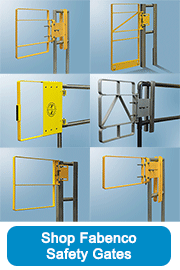
Your industrial facility is full of potential risks to workers and visitors. Among the most serious is the risk of falls. While slip and fall accidents can happen anywhere in your facility, stairways are among the most serious fall hazards and frequent sites of falling incidents. It’s vital that you focus your attention on providing adequate fall protection such as safety gates at stairway entrances to minimize risks and ensure OSHA compliance.
When Does OSHA Require Fall Protection for a Stairway?
As a safety manager or industrial facility owner you may already be aware that OSHA 1910.28 requires you to protect workers from falls as well as from falling objects. That means you need to provide guardrails, a safety gate, or personal fall protection whenever people are working 4′ or more above the level below. OSHA 1926.1052 specifies the guidelines for protecting stairways including:
- Stairways with four or more risers, rising to a height of 30″ or more need a handrail and guardrail.
- Stairs have to be installed at 30° to 50° from horizontal.
- Stair height and the depth of treads must be uniform.
- There must be 6′ 8″ of vertical clearance above the stairs.
- Each step must be able to handle 5x the intended load.
Is a Stairway Gate Required by OSHA?

- An off-set or safety gate must protect the entrance to any stairway or other exposed opening 4′ above the level below.
- A stairway gate must open away from the stairway entrance hole.
- If a gate opens onto a stairway platform, it cannot reduce the space to a depth of less than 20″.
- Safety gates used for stairways and other floor openings must be self-closing, per OSHA 1910.28(b).
What are the Benefits of Installing a Stairway Gate?
As manager or owner of an industrial facility, you want to make sure that you’re making the right investments for your employees and for your company. When it comes to making sure your workers are safe at height, safety gates are essential. Obviously, the main benefit of installing a gate on a stairway is that it helps eliminate falls from the top of the stairs. There are a couple of ways that gates for stairs help minimize fall hazards including:
- Slowing workers down to wait for the gate to open, thus increasing safety.
- Restricting access to stairways for authorized personnel only.
- Warning workers of a stairway that’s low-visibility or difficult to navigate.
- Preventing workers or vehicles from accidentally entering a stairway.
- A safety gate along with guardrails and handrails help ensure your OSHA compliance.
What Are Some Other Ways to Improve Stairway Safety?
Even if you install an OSHA-compliant guardrail system and safety gate for your facility’s stairways, don’t stop there. Remember that there is no such thing as being too safe, and you’re going to want to do everything you can to protect workers.
As part of your stairway safety plan, you should:
- Use high-contrast paint or tape to highlight the stair leading edges.
- Post signage warning of the upcoming stairway.
- Provide adequate lighting in stairways and on stairs where needed.
- Keep stairways clear of debris.
- Maintain dry stair treads.
- Do not store equipment or supplies on stairs.
- Practice good housekeeping and regularly clean the stairs.
In addition to making sure your stairways are clean and well-lit, you’ll also want to provide employees with adequate training to avoid falls. Although it does not seem like you’d need to, training employees how to use stairways safely is essential. Some things you’ll want to point out include:
- Walk, don’t run on stairways.
- Always hold the handrail with at least one hand.
- Take one step at a time, do not skip steps.
- Avoid carrying loads that limit your visibility.
- Do not lean over the railing at any time.
- Clean up any spills immediately to protect others.
Do I Need a Professional to Install Safety Gates, Guardrails, and Handrails?
The truth is that safety rails, handrails, and stairway gates can commonly be installed by anyone with average knowledge of tools. But you should be very careful whenever installing gates for stairs or any fall safety equipment on your own. If you don’t install it properly, the fall hazard you’re trying to mitigate may become worse. Plus, you could end up with an issue of being out of compliance with OSHA, which could end up costing you dearly.
Instead of trying to tackle the selection and installation of your facility’s safety equipment yourself, you should be recruiting a qualified safety expert to help you. If you need help with your facility’s safety systems, contact us and we’ll be happy to help you make these important decisions, so your workers stay safe and your facility stays productive.





